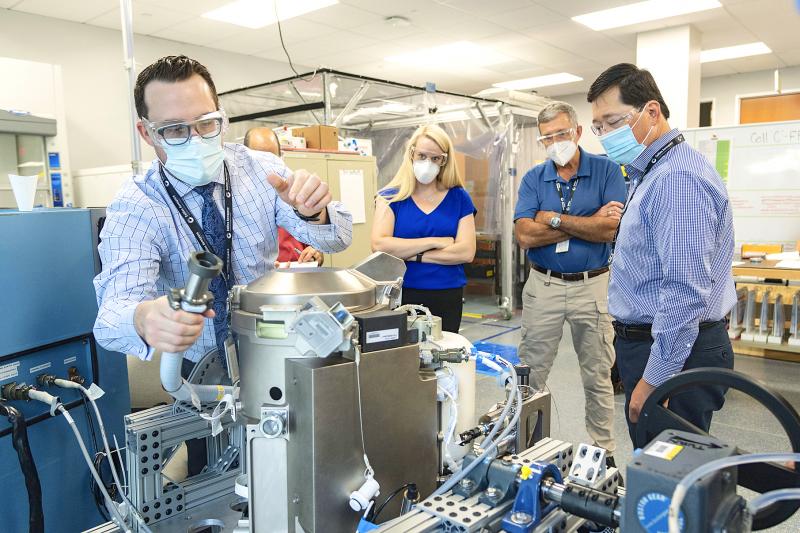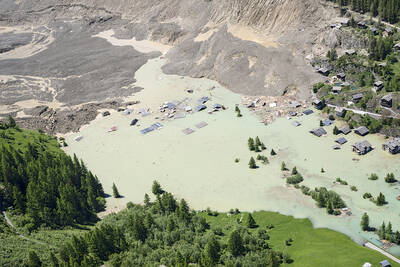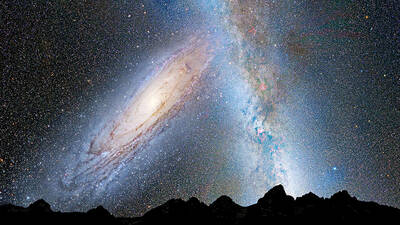NASA’s first new space potty in decades — a US$23 million titanium toilet better suited for women — is getting a not-so-dry run at the International Space Station before eventually flying to the moon.
It is packed inside a cargo ship that should have blasted off late on Thursday from Wallops Island, Virginia, but the launch was aborted with just two minutes remaining in the countdown.
Northrop Grumman said that it would try again yesterday if engineers could figure out what went wrong.

Photo: AP / NASA
Barely 45kg and just 71cm tall, the new toilet is roughly half as big as the two Russian-built ones at the space station. It is more camper-size to fit into the NASA Orion capsules that are due to carry astronauts to the moon in a few years.
Station residents are to test it out for a few months. If the shakedown goes well, the toilet would be open for regular business.
With SpaceX now launching astronauts to the space station and Boeing less than a year from sending up its first crew, more toilets are needed. The new one is to be in its own stall alongside the old one on the US side of the station.
The old toilets cater more toward men.
To better accommodate women, NASA tilted the seat on the new toilet and made it taller. The new shape should help astronauts position themselves better for a “No. 2,” Johnson Space Center project manager Melissa McKinley said.
“Cleaning up a mess is a big deal. We don’t want any misses or escapes,” she said.
Everything floats in space.
As for having a “No. 1,” the funnels have also been redesigned. Women can use the elongated and scooped-out funnels to urinate while sitting on the commode to poop at the same time, McKinley said.
Until now, it has been one or the other for female astronauts, she added.
Like earlier space commodes, air suction, rather than water and gravity, removes the waste.
Urine collected by the new toilet is to be routed into NASA’s long-standing recycling system to produce water for drinking and cooking. Titanium and other tough alloys were chosen for the new toilet to withstand all the acid in the urine.
Going to the bathroom in space might sound simple, but “sometimes the simple things become very difficult” without gravity, said NASA astronaut Mike Hopkins, commander of the second SpaceX crew, due to launch on Oct. 31 from Kennedy Space Center.
While the old design is not that hard to use, subtle design changes can make all the difference for women, said NASA astronaut Shannon Walker, a former space station resident who is also on the next SpaceX crew.
“Trust me, I’ve got going to the bathroom in space down, because that is a vital, vital thing to know how to do,” Walker said earlier this week.
The typical population of the space station is to go from six to seven with the next SpaceX flight, and even more when non-professionals, such as tourists, start traveling up as early as next year.
Astronauts normally stay six months.
The last time NASA ordered a new toilet was in the early 1990s to accommodate two-week Space Shuttle missions. The agency contracted with Collins Aerospace to provide the latest model — the company also worked on the shuttle potties.
Also in the 3,600kg shipment aboard Northrop Grumman’s Cygnus capsule are air tanks to make up for a slight space station leak; radish seeds for greenhouse growing; and a cinematic 360-degree virtual-reality camera for spacewalk shots.
Perhaps the most unique payload: Estee Lauder’s newest wrinkle serum.
The cosmetics company is paying US$128,000 for an out-of-this-world photo shoot, part of NASA’s push to open the final frontier to marketing, industry and tourism.
However, do not count on perfumed aromas to counter bathroom odors.
The serum is fragrance-free and the 10 bottles are to remain sealed until returned to Earth early next year.

The collapse of the Swiss Birch glacier serves as a chilling warning of the escalating dangers faced by communities worldwide living under the shadow of fragile ice, particularly in Asia, experts said. Footage of the collapse on Wednesday showed a huge cloud of ice and rubble hurtling down the mountainside into the hamlet of Blatten. Swiss Development Cooperation disaster risk reduction adviser Ali Neumann said that while the role of climate change in the case of Blatten “still needs to be investigated,” the wider impacts were clear on the cryosphere — the part of the world covered by frozen water. “Climate change and

Poland is set to hold a presidential runoff election today between two candidates offering starkly different visions for the country’s future. The winner would succeed Polish President Andrzej Duda, a conservative who is finishing his second and final term. The outcome would determine whether Poland embraces a nationalist populist trajectory or pivots more fully toward liberal, pro-European policies. An exit poll by Ipsos would be released when polls close today at 9pm local time, with a margin of error of plus or minus 2 percentage points. Final results are expected tomorrow. Whoever wins can be expected to either help or hinder the

DENIAL: Musk said that the ‘New York Times was lying their ass off,’ after it reported he used so much drugs that he developed bladder problems Elon Musk on Saturday denied a report that he used ketamine and other drugs extensively last year on the US presidential campaign trail. The New York Times on Friday reported that the billionaire adviser to US President Donald Trump used so much ketamine, a powerful anesthetic, that he developed bladder problems. The newspaper said the world’s richest person also took ecstasy and mushrooms, and traveled with a pill box last year, adding that it was not known whether Musk also took drugs while heading the so-called US Department of Government Efficiency (DOGE) after Trump took power in January. In a

It turns out that looming collision between our Milky Way and Andromeda galaxies might not happen after all. Astronomers on Monday said that the probability of the two spiral galaxies colliding is less than previously thought, with a 50-50 chance within the next 10 billion years. That is essentially a coin flip, but still better odds than previous estimates and farther out in time. “As it stands, proclamations of the impending demise of our galaxy seem greatly exaggerated,” the Finnish-led team wrote in a study appearing in Nature Astronomy. While good news for the Milky Way galaxy, the latest forecast might be moot